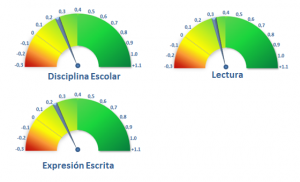Implementing institution: Catch Up
Country: United Kingdom
Source: Education Endowment Foundation
Execution period: 1998 - in progress
Plataforma de Prácticas Efectivas:
To increase the reading performance of children who find it more difficult to read.
An individualized reading reinforcement program with innovative manuals.
A positive and statistically significant impact of the Catch Up Literacy program was highlighted in the improvement of school discipline (+0.25 SD), in the improvement of reading (+0.32) and in the promotion of written expression (+0.23).
Catch Up Literacy is a reading performance enhancement program for students ages 6 to 14 who have difficulty learning to read. It was initially developed in 1998 for children 6 to 8 years of age based on the research results of Diana Bentley, Suzi Clipson-Boyles and Dee Reid. Later, the programme was extended to young people up to 14 years of age, because dramatic gaps in their reading skills were evident in the youth population.
Through a wide range of accessible online books (8,000), the aim is to strengthen students’ abilities to combine phonemes (combine sounds of letters into words), segment phonemes (separate words into sounds of letters), and memorize particular words so that they can be understood without the need for phonetic strategies to decode them. The books have been divided into 12 levels of difficulty, so that each student, according to their initial and evolutionary performance, has access to a manual adapted to their needs.
The intervention consists of 4 stages:
(ii) Selection of books appropriate to their abilities and tastes.
(iii) Two reading aloud sessions per week.
(iv) Continuous monitoring of progress and related improvement strategies.
Reading aloud sessions are individual and supervised by a tutor (education assistant), who is responsible for monitoring the reader’s progress. These last 15 minutes which are divided into: preparation for reading (3min); the actual reading and discussion of the text (6min); and writing a summary (6min). Sessions are given for 30 weeks, after which the student takes a test to see whether or not he or she is still in the program. For a correct performance of the intervention, the Catch Up Foundation trains the teachers who train the tutors during 4 sessions of 60 to 90 minutes each. They are also given methodology manuals that summarize all the steps to be followed and the corresponding strategies. All those teachers are grouped in the Catch Up community, where they can access online support and discuss their doubts.
In England, the enrolment of children at elementary and secondary level covers almost the entire population of attendance age (99.85% and 98.28% respectively in 2014). Net participation rates have been growing since 2006, especially at the secondary level (+6 percentage points). However, the OECD’s PISA survey has highlighted a decline in reading literacy levels among part of the 15-year-old English population since 2011.
Between 2013 and 2014, the National Foundation for Educational Research evaluated the Catch Up Literacy program with funding from the Education Endowment Foundation. The experimental study involved 60 students from 15 different schools who were divided into three groups: one group received conventional courses (A); another one that participated in the intervention (B); and the third one, that received nothing (C). Information was gathered from individual interviews with students and teachers, as well as from the results of the New Group Reading Test.
The comparison of the results highlighted a positive and statistically significant impact of the Catch Up Literacy program in improving school discipline (+0.25 SD), in improving reading (+0.32), and in promoting written expression (+0.23). Teachers have very positive comments about the program because it increases their satisfaction with the work and improves their relationship with the students.
At an average cost of £769 per student per year, the program represents a feasible innovation for low-income countries.
Impact of interventions:


Charts: Impact measured in standard deviations of the intervention group compared to the control group.
Tags: